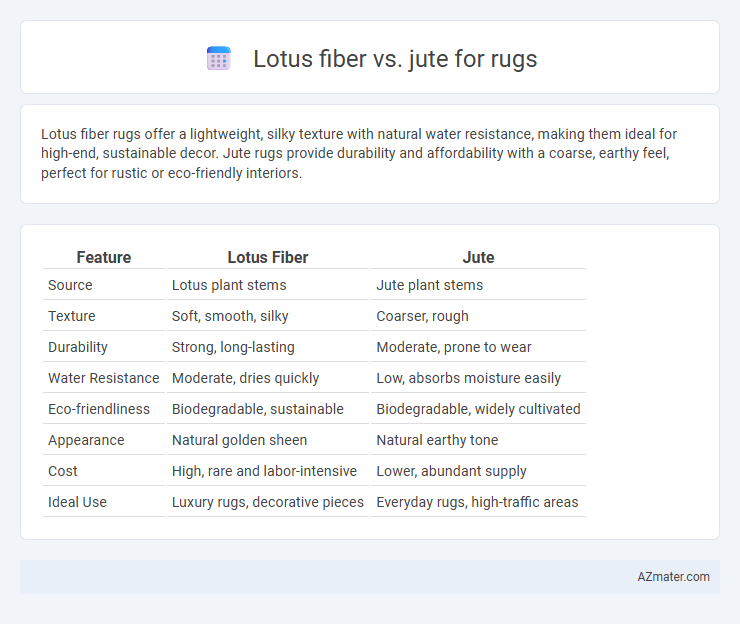Lotus fiber rugs offer a lightweight, silky texture with natural water resistance, making them ideal for high-end, sustainable decor. Jute rugs provide durability and affordability with a coarse, earthy feel, perfect for rustic or eco-friendly interiors.
Table of Comparison
| Feature | Lotus Fiber | Jute |
|---|---|---|
| Source | Lotus plant stems | Jute plant stems |
| Texture | Soft, smooth, silky | Coarser, rough |
| Durability | Strong, long-lasting | Moderate, prone to wear |
| Water Resistance | Moderate, dries quickly | Low, absorbs moisture easily |
| Eco-friendliness | Biodegradable, sustainable | Biodegradable, widely cultivated |
| Appearance | Natural golden sheen | Natural earthy tone |
| Cost | High, rare and labor-intensive | Lower, abundant supply |
| Ideal Use | Luxury rugs, decorative pieces | Everyday rugs, high-traffic areas |
Introduction to Lotus Fiber and Jute Rugs
Lotus fiber rugs, made from the natural thread extracted from lotus stems, offer exceptional softness, durability, and eco-friendly properties compared to traditional jute rugs. Jute rugs, derived from the coarse, shiny fibers of the jute plant, are renowned for their affordability, rustic texture, and biodegradability. Both materials provide sustainable options for home decor, with lotus fiber rugs standing out for their unique botanical origin and premium craftsmanship.
Origin and Production Processes
Lotus fiber, derived from the stems of lotus plants primarily found in Myanmar and Thailand, involves an intricate, labor-intensive extraction process where fibers are hand-peeled, sun-dried, and spun into delicate threads, making it a rare and eco-friendly material. In contrast, jute, grown predominantly in India and Bangladesh, is obtained through retting, where harvested stalks are soaked in water to loosen fibers before being combed and spun, allowing for large-scale, cost-effective production. The unique origin and artisanal processing of lotus fiber result in a finer, softer texture suited for luxury rugs, while jute's robust, coarse fiber supports durability and affordability in rug making.
Material Composition and Characteristics
Lotus fiber rugs are made from natural threads derived from the lotus plant's stems, known for their lightweight, water-resistant, and silky texture, offering a unique softness and durability. Jute rugs consist of coarse, strong fibers extracted from the jute plant's outer bark, characterized by their rough texture, high tensile strength, and excellent biodegradable properties. While lotus fiber excels in luxury and subtle sheen, jute provides affordability and rugged resilience suitable for heavy traffic areas.
Durability and Longevity Comparison
Lotus fiber rugs offer exceptional durability due to their natural strength and resistance to wear, making them ideal for high-traffic areas. Jute rugs, while eco-friendly and affordable, tend to have lower longevity as they are more prone to fraying and moisture damage. Choosing lotus fiber results in a longer-lasting rug with better resilience against daily use compared to jute.
Comfort and Texture Differences
Lotus fiber rugs offer a unique softness and smooth texture that is often compared to fine silk, making them exceptionally comfortable underfoot. In contrast, jute rugs have a coarser, more rustic feel with a rougher texture that provides a natural, earthy aesthetic but less cushioning comfort. The lightweight and breathable nature of lotus fiber enhances comfort, while jute's durability and dense weave contribute to its robust texture and resilience.
Sustainability and Eco-Friendliness
Lotus fiber rugs offer exceptional sustainability due to the fiber being harvested from lotus stems without cutting the plant, enabling natural regeneration and minimizing ecological impact. Jute rugs, made from the fast-growing jute plant, are abundant and biodegradable but often require chemical fertilizers and pesticides, affecting eco-friendliness. Choosing lotus fiber favors a zero-waste process and supports water conservation, while jute remains a cost-effective, renewable option with moderate environmental footprint.
Aesthetic Appeal and Design Variations
Lotus fiber rugs offer a unique, smooth texture with a natural sheen, lending an organic and luxurious aesthetic that enhances minimalist and contemporary interiors. In contrast, jute rugs present a coarse, rustic look with a matte finish, ideal for bohemian or farmhouse styles emphasizing earthy tones and natural patterns. Design variations in lotus fiber rugs tend to highlight subtle, intricate weaves, while jute allows for diverse patterns and durability, making it versatile for high-traffic areas.
Maintenance and Care Requirements
Lotus fiber rugs require gentle cleaning with mild detergents and air drying to preserve their natural luster and prevent fraying, while avoiding excessive moisture is crucial due to their delicate structure. Jute rugs are more resilient but demand regular vacuuming and quick spill cleanup to prevent staining and mold growth, given their absorbent nature. Both fibers benefit from rotation to ensure even wear, but lotus fiber's maintenance is generally more labor-intensive compared to the relatively low upkeep of jute.
Cost Analysis: Lotus Fiber vs Jute Rugs
Lotus fiber rugs typically cost more than jute rugs due to the labor-intensive extraction process and limited availability of lotus fibers compared to the widely grown and harvested jute. The higher price of lotus fiber reflects its unique texture, durability, and eco-friendly production methods, whereas jute offers a budget-friendly, biodegradable option with moderate durability. Buyers seeking sustainable luxury may prefer lotus fiber despite the premium, while cost-conscious consumers often choose jute for affordable and stylish natural fiber rugs.
Best Applications and Buying Recommendations
Lotus fiber rugs offer a unique, eco-friendly option with their lightweight texture and natural sheen, ideal for low-traffic areas and decorative purposes, while jute rugs provide durability and rustic charm, making them well-suited for high-traffic spaces and natural-themed interiors. Buyers seeking sustainable materials with a luxury feel should consider lotus fiber for accent rugs or wall hangings, whereas those needing cost-effective, robust flooring solutions benefit from jute's resilience and easy maintenance. Choosing between lotus fiber and jute depends on the rug's intended use, desired aesthetic, and environmental considerations to ensure maximum longevity and style coherence.

Infographic: Lotus fiber vs Jute for Rug
 azmater.com
azmater.com